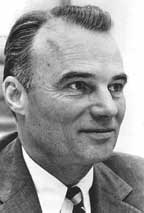Obituary
Henry Loomis, 89, CPB president in tense Nixon years
 Henry Loomis, the CPB president ordered to take back programming control from PBS during the Watergate years, died Nov. 2 at the age of 89 in Jacksonville, Fla.
Henry Loomis, the CPB president ordered to take back programming control from PBS during the Watergate years, died Nov. 2 at the age of 89 in Jacksonville, Fla.
His family said he succumbed to complications from Alzheimer’s, Parkinson’s and Pick’s diseases.
Loomis, a gentleman scientist with experience in intelligence and early radar research, had earlier served as director of Voice of America from 1958 to 1965 and quit in protest when President Lyndon Johnson ordered the government’s overseas radio service not to report that U.S. jets were flying over Laos.
His point was that agency’s news broadcasts were “the voice of America, not the voice of the administration,” recalls Donald Quayle, a prominent public broadcaster who later worked for Loomis at CPB.
But Loomis took a contrasting position eight years later at CPB, after President Richard Nixon recruited him to be the corporation’s second president.
It was September 1972, and the Watergate scandal was emerging from cover. For months the White House had been pressing public TV to stop airing national public affairs productions backed by the liberal Ford Foundation — then a major funder of pubTV programming. Nixon had vetoed pubcasting’s reauthorization bill in June, charging that CPB was becoming “the focal point of control for the entire public broadcasting system.” CPB Chair Frank Pace, President John Macy and other CPB execs quit in protest.
CPB Board members who shared Nixon’s concerns backed a board resolution in January 1973 declaring that it would repossess from PBS the roles of public TV production funding and acquisition. CPB alerted producers that it, instead of PBS, would henceforth consider program proposals, WNET/NET chief James Day later wrote in his history of the field, The Vanishing Vision. Most PBS public affairs programs, including an early version of Bill Moyers’ Journal, were dropped, Day said.
Loomis later said he had refused to assist the White House campaign to remove public affairs programming from public TV. Though Nixon aides were writing memos about cracking down on PBS, “that doesn’t mean it was accepted or anybody did anything about it,” Loomis said during a 1993 meeting of public TV retirees.
Quayle, who was NPR’s founding president and later worked for Loomis as CPB’s senior v.p. for broadcasting, agrees that Loomis didn’t want to squelch public affairs programming or to fire Robert MacNeil, then host of Washington Week in Review, as Nixon appointees wished. Quayle believes Loomis took part in the crackdown out of “either naivety or misinformation.” At that point, Quayle says, Loomis “didn’t really understand how public broadcasting was structured.”
After all, he had begun his CPB appointment with the admission he had never seen public TV. One of his few connections to the field was that he had been an aide to James Killian at the Massachusetts Institute of Technology before Killian chaired the Carnegie Commission that played a key role in creating public broadcasting.
Later, Quayle recalls, when Loomis grasped the nature of the field, “he referred to it as a duck-billed platypus, the reason being because it is one of a kind.”
Though Nixon partisans presented its moves as reforms promoting station autonomy, public TV seized the banner of localism and ran with it. Ralph B. Rogers — the Dallas business executive regarded by James Day and others as the savior of public TV’s independence — led PBS’s transformation from a CPB creation into an association of stations. Fans of canceled programs also objected by the thousands, and Congress forced CPB to compromise its takeover, Day wrote.
Loomis later tussled with PBS, positioning CPB as the originator of new series and leaving PBS to pay for them after the second year, according to Day. He resigned in 1978, after Democrat Jimmy Carter took control of the White House and CPB appointments.
Loomis met his second wife, Jacqueline Chalmers, through her work as a volunteer with WJCT in Jacksonville, according to Quayle.
Survivors include Jacqueline, four children from his first marriage and four stepsons, according to news reports.
Web page posted Nov. 26, 2008
Copyright 2008 by Current LLC